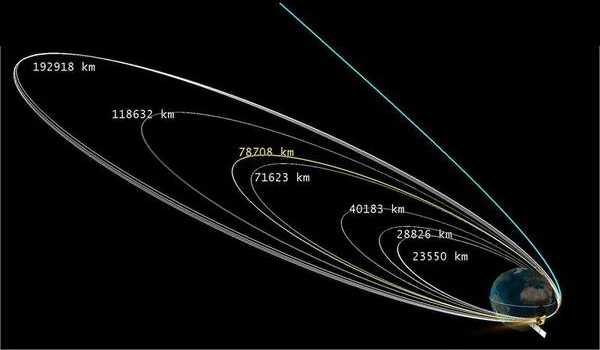
Image Description: The orbital maneuvers of the Indian probe around Earth to position itself on an optimized trajectory to Mars. The probe used its main engine several times to benefit from Earth's gravitational acceleration. This compensated for the weakness of the Indian launcher. In return, the probe had to carry a lot of fuel to reach sufficient speed and leave Earth's orbit, then insert itself on a trajectory to Mars. The fourth maneuver, which was supposed to raise the probe to the next orbit, was prematurely interrupted due to a minor engine failure. This reduced the additional impulse, and the probe could only accelerate by 35 m/s instead of the planned 135 m/s. Image Source: ISRO.
The Mars Orbiter Mission (MOM), also known as Mangalyaan, is India's first space probe to explore Mars. Launched by the Indian Space Research Organisation (ISRO) on November 5, 2013, the probe entered Mars orbit on September 24, 2014. This mission marked a significant milestone for India, making it the first nation to successfully reach Mars on its first attempt.
The primary objectives of the Mars Orbiter Mission were to demonstrate India's technological capabilities in interplanetary missions and to conduct scientific studies of Mars. The scientific objectives included studying the Martian surface, its atmosphere, and exosphere. The probe was equipped with five scientific instruments to carry out these studies.
The MOM probe was equipped with five scientific instruments:
The Mars Orbiter Mission provided valuable data about Mars, including high-resolution images of the surface, information on mineral composition, and measurements of methane presence in the atmosphere. These discoveries have contributed to a better understanding of the red planet and paved the way for future exploration missions.
The mission faced several technical challenges, including managing long-distance communication and precise navigation to enter Mars orbit. However, through meticulous planning and precise execution, ISRO successfully overcame these challenges and achieved its objectives.
The Mars Orbiter Mission was a resounding success for India, demonstrating its technological and scientific capabilities in space exploration. The mission not only provided valuable data about Mars but also inspired a new generation of scientists and engineers in India and around the world.